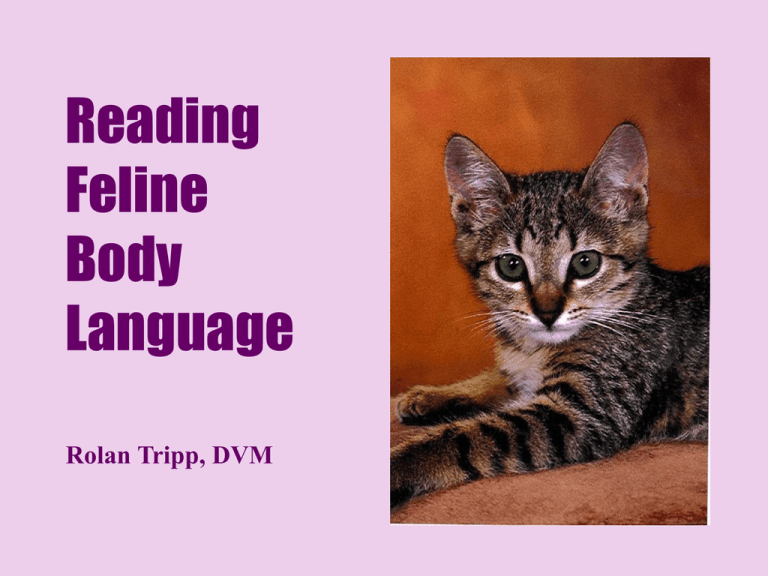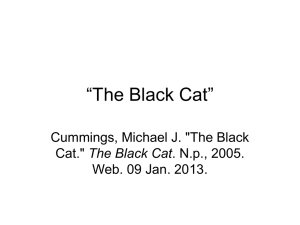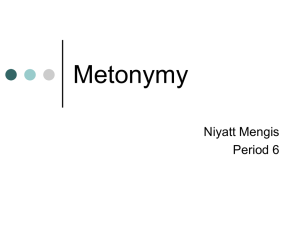Normal Body Language - Animal Behavior Network
advertisement

Reading Feline Body Language Rolan Tripp, DVM Body Language Terminology • Distance increasing behaviors vs. Distance reducing behaviors • Concordance of Signals = many signals all giving the same message. vs. Discordance = body language giving conflicting messages. © Rolan Tripp, DVM 2 Purring • • • • Contentment May occur when in pain or just before dying = “Seeking companionship” = Distance decreasing © Rolan Tripp, DVM 3 Feline Greeting Postures • Many cats roll to greet • Exposing vulnerable belly is a sign of trust • Tail straight up is “willing to interact”. © Rolan Tripp, DVM 4 Feline Greeting Postures - Tail • The tail base up is confident • Tail tip up or curved is willing to interact or friendly • Tail swishing is Conflict. © Rolan Tripp, DVM 5 Feline Greeting Postures – Head Rubbing = “Bunting” • Pheromone Production – Cheek Glands – just above each lip • Tends to rub/mark objects with cheeks – Pre-auricular Glands = just in front of each ear • Tends to rub/mark beings with head • This is the basis for “Feliway” product. © Rolan Tripp, DVM 6 “Feliway” “Feline Facial Pheromone Analog”… Changes the site from a urine mark target to a cheek mark target Calming effect. © Rolan Tripp, DVM 7 “Attentive Anxious” • Eyes open, focused • Ears forward focused • Whiskers forward • Weight on rear quarters for rapid response • Muscle tone • Tail twitching. © Rolan Tripp, DVM 8 Recognizing Feline Aggressive Body Postures © Rolan Tripp, DVM 9 © Rolan Tripp, DVM 10 Defensive Postures • Cat attempts to look BIGGER – – – – Arched back Fluffed tail Piloerection Nails exsheathed • Look at leg position – Full extension = confident – Crouched low = insecure, fearful © Rolan Tripp, DVM 11 Defensive Aggression Pariah threat posture • Low ranking threatened cat • Crouched front legs • Ears back • Teeth bared • Sign of fear and insecurity. © Rolan Tripp, DVM 12 Defensive Aggression “Lateral Threat” Posture • Cat uses every possible technique to appear larger: • Piloerection (Fluffed) • Arched back • Turns to side to seem BIGGER. © Rolan Tripp, DVM 13 Defensive Postures • Full defensive aggressive posture – – – – Laying on back Teeth bared Whiskers back Front and rear claws exsheathed and ready – Tail switching for balance and communicating anger © Rolan Tripp, DVM 14 Cat-Cat Aggression Postures • Eye to eye • Ears forward • Tails out and back swishing for balance and communication • Low center of gravity • Piloerection • Forward whiskers. © Rolan Tripp, DVM 15 Flehmen posturing – “Volmeronasal Organ” is a secondary olfactory system – Odors enter near the hard palate inside the mouth – Used for special odors like urine or reproductive pheromones © Rolan Tripp, DVM 16 Female Reproductive Posture • Male is selected, allowed to approach • Female in estrus assumes “lordosis” pose • Tail to the side • Presents ano-genital area for sniffing. Female in “Lordosis” pose © Rolan Tripp, DVM 17 Male Reproductive Posture • Tom does neck bite to stabilize female and protect self • Treading and stepping movements position pelvis for coitus. © Rolan Tripp, DVM 18 Urine Marking = “Spraying” • Cat backs up to target • Tail is straight up and quivering • Small amounts of urine are sprayed up and out to mark object © Rolan Tripp, DVM 19 Marking territory with paws • Leaves scent mark from pads • Plus visual mark from claws • Also satisfies need for stretching and sharpening claws. © Rolan Tripp, DVM 20 What is this kitten saying? Eyes: Focused Ears: Forward and up = Focused Nose: Up and forward = Focused Throat: Solicitation Body: Feet off ground = Non-threatening “Please let me out!” Tail: Base up, tip up = Friendly, willing to interact What is this kitten saying? “Thanks for letting me out. Now stop threatening me.” Eyes: Looking away = Disinterested, or disarming Ears: To side and back = Uncertain Nose: Turned partially away = Distance increasing Tail: Up and curved forward = Distance decreasing (Above include discordant signals) HUMAN: Back arched; Staring; Claws and teeth exposed; = Trying to be friendly; actually being threatening Kittens in Kindergarten (Don’t know each other) Orange Kitten on right… Eyes: Focused = Attentive Ears: Full front = Alert, focused, confident Body: Back mildly arched Body: Rump setting down = slowing rate of interaction (SIT is a STOP message). Tail: Base up, tip straight = Confident/Neutral. • B&W Kitten on Left… • Eyes: Focused = Attentive • Ears: Up, forward = Interested and focused • Body: Arched back = Trying to intimidate. • Body: One paw raised = Impending (undetermined) change of behavior • Tail: Base up, tip up = Very willing to interact Kittens in Kindergarten (Don’t know each other) Grey Kitten on right… Eyes: Turned =some new interest Ears: Full front elsewhere = Alert, focused, confident Nose: Whiskers forward = Confident Body: Neck and shoulder exposed to new cat = no worry of attack (confident) Tail: Base up, tip straight = Confident/Neutral. Striped Kitten On Left… Eyes: Focused = Attentive Ears: Out + back = Anxious and uncertain Nose: Whiskers out = Gathering data Body: Approaching slowly at an arc = Non-confrontive approach Tail: Base Down, Tip up = Cautious but willing to interact Dog confronts cat. What is cat signaling? • • • • • • • Eyes: Wide, pupils dilated = High arousal Ears straight out = ½ way between fear and attack Throat: Growl = Distance increasing Paw: Raised = Impending change; Threat Body: Tense; Backed up to wall = Ready to spring Tail: Tucked = Distance increasing Dog is looking away, ears fully up, debating options. © Rolan Tripp, DVM 25 One stressed cat in a happy group • • • • Orange tabby has tail tucked which is unfriendly Shoulder, ear position give away threat Target of threat is unfazed suggesting senior status Stressed cat is thinnest of group. © Rolan Tripp, DVM 26 These cat tails signal coming and going. Overall lack of social tension. • Cats entering group have tails up • Cat leaving has lower tail • Orange tabby in rear is signaling an alliance by contact – He is fully stretched out facing away; belly exposed = high trust © Rolan Tripp, DVM 27 Affiliative Behavior © Rolan Tripp, DVM (Cats are social!) 28 Unwanted Male Cat Behavior © Rolan Tripp, DVM 29 Questions? © Rolan Tripp, DVM 30








